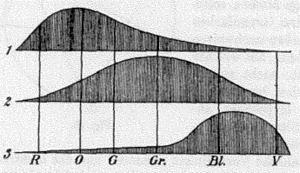The Young–Helmholtz theory (based on the work of Thomas Young and Hermann von Helmholtz in the 19th century) is a theory of trichromatic color vision – the manner in which the photoreceptor cells in the eyes of humans and other primates work to enable color vision. In 1802, Young postulated the existence of three types of photoreceptors (now known as cone cells) in the eye, each of which was sensitive to a particular range of visible light.Hermann von Helmholtz developed the theory further in 1850: that the three types of cone photoreceptors could be classified as short-preferring (blue), middle-preferring (green), and long-preferring (red), according to their response to the wavelengths of light striking the retina. The relative strengths of the signals detected by the three types of cones are interpreted by the brain as a visible color.For instance, yellow light uses different proportions of red and green, but little blue, so any hue depends on a mix of all three cones, for example, a strong blue, medium green, and low red. Moreover, the intensity of colors can be changed without changing their hues, since intensity depends on the frequency of discharge to the brain, as a blue-green can be brightened but retain the same hue. The system is not perfect, as it does not distinguish yellow from a red-green mixture, but can powerfully detect subtle environmental changes.The existence of cells sensitive to three different wavelength ranges was first shown in 1956 by Gunnar Svaetichin. In 1983 it was validated in human retinas in an experiment by Dartnall, Bowmaker, and Mollon, who obtained microspectrophotopic readings of single eye cone cells. Earlier evidence for the theory had been obtained by looking at light reflected from the retinas of living humans, and absorption of light by retinal cells removed from corpses.




Comentar
0